Are you a student in Karnataka who is looking for comprehensive KSEEB 2nd PUC Maths Chapter 1 Relations and Functions Ex 1.3 Solutions? Look no further! In this page, you will get detailed and accurate solutions to help you master the concepts effectively.
These solutions are designed as per the syllabus of the Karnataka Secondary Education Examination Board (KSSEB). They simplify the concepts of Relations and Functions, making it easier for you to understand and solve the problems with confidence.
The KSEEB 2nd PUC Maths Chapter 1 Relations and Functions Ex 1.3 Solutions provided here cover every problem in a step-by-step manner. This ensures clarity and helps you strengthen your understanding of key mathematical concepts.
In this page, you will find reliable and easy-to-follow KSEEB 2nd PUC Maths Chapter 1 Relations and Functions Ex 1.3 Solutions, helping you prepare thoroughly for your exams. Make the most of these solutions and excel in your academic journey.
Karnataka 2nd PUC Maths Question Bank Chapter 1 Relations and Functions Ex 1.3
2nd PUC Maths Relations and Functions NCERT Text Book Questions and Answers Ex 1.3
Question 1.
Let f: {1, 3, 4} → {1,2, 5} and g : {1, 2, 5} {1,3} be given by f= {(1,2), (3,5), (4,1)} and
g = {(1, 3), (2, 3), (5,1)}. Write down gof.
Answer:
gof (1) = g (f (1)) = g (2) = 3 gof (3)
= g {f (3)} = g (5) = 1
= gof (4) = g (f (4)) = g (1) = 3
∴ gof = {(1,3), (3,1), (4,3)}
Question 2.
Let f, g and h be functions from R to R. Show that
(f + g)oh =foh + goh
(f.g)oh = (foh) . (goh)
Answer:
∀ x ∈ R
{(f + g)oh} (x) = (f + g) h (x)
= f (h (x)) + g (h (x)) = foh (x) + goh (x)
= {foh + goh} (x)
∴ (f + g) oh = foh + goh
((fg )oh) (x) = (f.g) (h (x))
= fh (x). gh (x)
= {foh (x)} . {goh (x)}
{foh. goh} (x)
(fg) oh = (foh) (goh)
Question 3.
Find gof and fog, if
(i) f(x) = |x| and g(x) = |5x – 2|
Answer: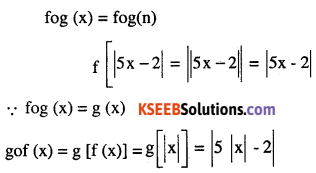
(ii) f (x) = 8x3 and g(x) = x1/3
Answer: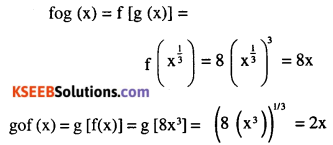
Question 4.
If f(x)=(4x+3)/(6x−4),x≠2/3,show that fof(x)= x,for all
x≠2/3,what is the inverse off?
Answer: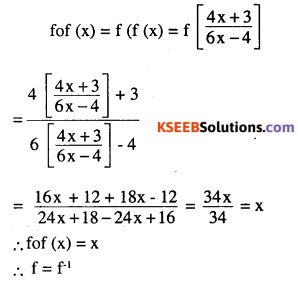
Question 5.
State with reason whether following functions have inverse
(i) f : {1,2, 3, 4} → {10} with
f = {(1, 10), (2, 10), (3, 10), (4, 10)}
(ii) g : {5, 6, 7, 8} → {1, 2, 3, 4} with
g = {(5, 4), (6, 3), (7, 4), (8, 2)}
(iii) h : {2, 3, 4, 5} → {7, 9,11,13} with
h = {(2, 7), (3, 9), (4, 11), (5, 13)}
Answer:
(i) f (1) = f (2) = f (3) = f (4) = 10
⇒ f is not one-one
∴ f does not have an inverse
(ii) g(5) = 4 g(6) = 3 g(7) = 4 g(8) = 2 g(5) = g(7) = 4
∴ g is not one-one, hence g does not have inverse
(iii) h(2) = 7, h(3) = 9, h(4) = 11, h(5)=13,
∴ h is one-one
Also range of h = {7,9,11,13} = co-domain
⇒ h is onto
Hence h has an inverse
h-1 = {(7,2), (9,3), (11,4), (13, 5)}.
Question 6.
Show that f: [-1,1] → R, given by f(x) =x/(x+2) is one-one. Find the inverse of the function f : [-1,1] → Range f.
(Hint: For y∈ Range f,y=f(x)=x/x+2 for some x in [-1,1]
x=2y/(1−y)
Answer: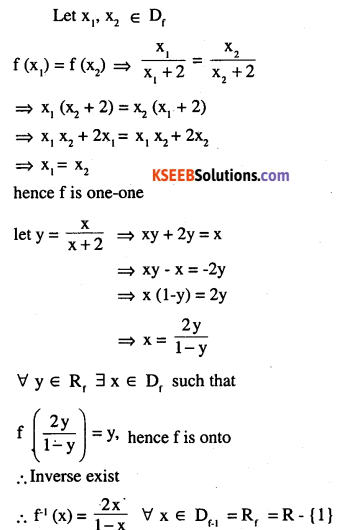
Question 7.
Consider f : R → R given by f(x) = 4x + 3. Show that f is invertible. Find the inverse of f.
Answer: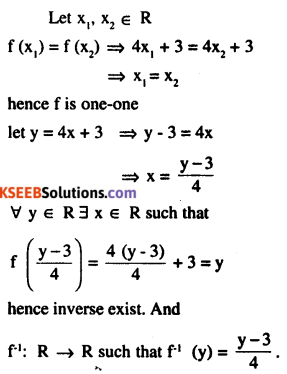
Question 8.
Consider f : R+ → [4, ∞) given by f(x) = x2 + 4. Show that f is invertible with the
inverse f-1 of/given by f−1(y)=y−4−−−−√ . where R+ is the set of ail non-negative real numbers.
Answer: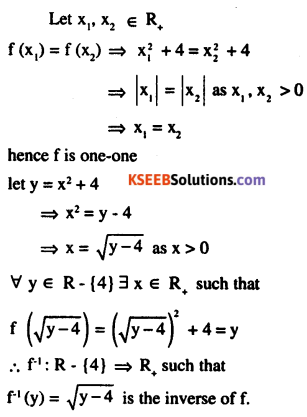
Question 9.
Consider f : R+ → [- 5, ∞) given by f (x) = 9x3 + 6x – 5. Show that f is invertible with
f−1(y)=((√y+√6)⋅1)/3
Answer: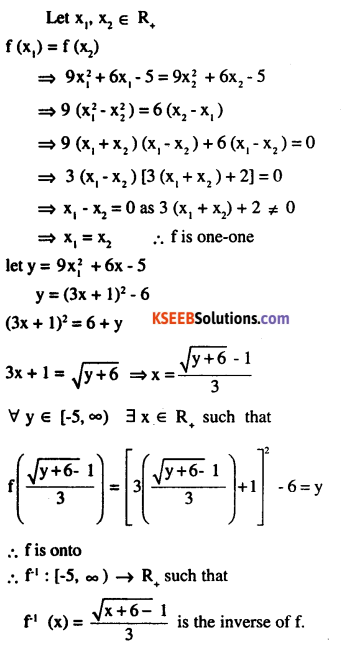
Question 10.
Let f : X → Y be an invertible function. Show that f has unique inverse. (Hint: suppose g1, and g2 are two inverses of f. Then for all y ∈ Y, fog1(y) as 1Y(y) = fog2(y). Use one-one ness of A
Answer:
Let g1 and g2 are two inverse of f, then for all y ∈ y
fog1 (y) = f [g (y)] = y = Iy (y)
fog2 (y) = f [g2 (y)] = y = Iy (y)
(fog1) (y) = (fog2) (y) ∀ y ∈ y
f(g1,(y)) = f (g2 (y)) ∀ y ∈ y
∴ g, (y) = g2 (y) (∴ f is one-one)
g1 =g2
⇒ Inverse of f is unique.
Question 11.
Consider f : {1, 2, 3} → {a, b, c} given by f(1) = a,f (2) = b and f(3) = Find f-1 and show that
(f -1)-1 = f
Answer:
Given that
f = {(1. a), (2, b), (3, c)}
f is one-one and onto
∴ f is invertible f-1 (a) = 1, f (b) = 2, f-1 (c) = 3,
∴ f1 (a, b, c} ⇒ {1,2, 3} is also one and onto
∵ Inverse of f is (f)-1 exist
(f1)-1 = {(1. a), (2, b), (3, c)}=f hence (f-1)-1 = f.
Question 12.
Let f : X → Y be an invertible function. Show that the inverse of f-1 is f, i.e., that (f -1)-1 = f
Answer:
Let f : X → Y is invertible
⇒ f is one and onto and
f-1 : Y ⇒ X is defined as f-1(y) = x
y : f (x) ∀ x ∈ X and y ∈ Y
let y1,y2 ∈ y
f-1 (y1) = f-2(y2)
fof1 (y1) = fof1 (y2)
Iy (y1) = Iy(y2)
⇒ y1 = y2 ∴ f1 is one-one
∀ x ∈ X, ∋ y ∈ Y such that
f1 (y) = x, hence f1 is onto
hence invertible.
let g = (f1)-1
gof-1 = Iy and f-1og = lx
∀ x ∈ X, Ix (x) = x
fof-1(x) = f-1 [g(x)] = x
fof-1 [g (x)] = f (x)
(fof-1) (g (x)) = f (x)
g (x) = f (x)
g = f
(f-1)-1 = f.
Question 13.
If f: R → R be given by f(x)=(3−x3)1/3,then fof (x) is
(A) x1/3
(B) x3
(C) x
(D) (3 – x3)
Answer: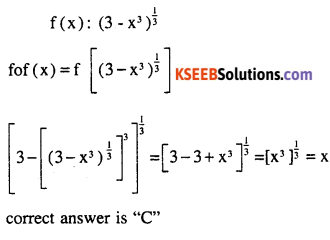
Question 14.
Let f:R−{−4/3}→R,be a function as f(x)=+4x/(3x+4).The inverse off is the mag g : Range
f→R−{−4/3} given by
(A) g(y)=3y/(3−4y)
(B) g(y)=4y/(4−3y)
(C) g(y)=4y/(3−4y)
(D) g(y)=3y/(4−3y)
Answer: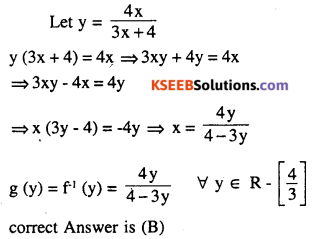
Conclusion: KSEEB 2nd PUC Maths Chapter 1 Relations and Functions Ex 1.3 Solutions
To conclude, the solutions provided for Chapter 1 Relations and Functions Exercise 1.3 in the KSEEB 2nd PUC Maths textbook offer a comprehensive understanding of the topic. The step-by-step explanations and examples provided in these solutions will greatly assist students in solving similar problems and mastering the concepts of relations and functions. To further enhance your understanding and excel in your studies, it is highly recommended to refer to these solutions for Chapter 1 Relations and Functions Exercise 1.3 in the KSEEB 2nd PUC Maths textbook.
